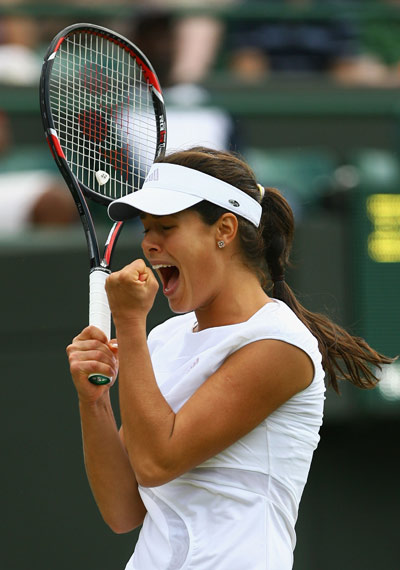
After dodging a bullet (or 50 of them) from Ernests Gulbis, Nadal should settle back into his comfort zone against a compatriot who specializes in armor rather than bullets. Ferrer’s sublime defense should prove much less dangerous to Rafa than the flat, sometimes Soderling-like groundstrokes relentlessly pounded by the Latvian. Only if the defending champion is weary from his semifinal exertions will the veteran have a chance, and one should recall the concluding weekend of this tournament in 2007. Despite enduring a grueling Saturday epic against Davydenko, Nadal briskly dispatched Gonzalez on Sunday. Once again, ’tis the season to be decking Nadal’s Mallorcan hall with laurel wreaths.
Lately, WTA finals have been either routine, ugly, or both; we’re thinking of Jankovic’s win over Wozniacki in Indian Wells, Clijsters’ win over Venus in Miami, and Stosur’s win over Zvonareva in Charleston. At first glance, the Stuttgart final might seem likely to follow that pattern, considering Henin’s utter dominance over the dirt before her retirement. But we think that a compelling contest could plausibly evolve between the recently invincible Australian and one of the greatest clay-court players in WTA history. As we mentioned in our previous post, this tournament represents a valuable opportunity to make an early statement before the competition intensifies in Rome and Madrid. Here are three pieces of advice for each finalist that could help them make that statement:
Stosur:
Utilize the wide serve: Not blessed with a Venus-like wingspan, Henin struggles to make solid contact on wide serves in both deuce and ad courts. She naturally leans slightly towards the T before the serve is struck, so Stosur should try to incorporate some kick serves on the first serve as well as the second serve in order to keep the Belgian off balance. The Australian will need to seize command of the points immediately rather than allowing Henin to start the rally in neutral mode.
Attack the net: Long an accomplished doubles player, Stosur possesse exceptional volleying skills and should exploit them to the fullest. Preferring to gradually settle into points, Henin often has said that she struggles against players who force her to rush. Net approaches will accomplish that goal by challenging her timing on passing shots, a little rusty during her comeback.
Take chances on returns: A little fragile in its modified form, Henin’s serve still represents her Achilles heel; it’s the only shot on which she’ll string together bunches of unforced errors (e.g., double faults). If Stosur can connect on a few return winners, Justine might lose confidence in the shot and in her overall game as a consequence. Moreover, relentless first-strike tennis would produce an arhythmic match in which Henin would win some easy points but could never quite relax. For her, the mental dimension is at least as important as the physical, and inner stress often emerges outwardly through her performance.
Henin:
Wait for the right opportunity: Significantly more consistent and more versatile than her opponent, Henin should take her time to construct points rather than pulling the trigger too early. She may need to dial back her ultra-aggressive new style a little, especially in the early stages when she is adjusting to Stosur’s distinctive game. Often inclined to aim for outright winners off service returns, she would be better served (haha) by connecting on high-percentage returns that allow her to start the point in neutral mode, from which she can steadily work the Australian out of position. If she concedes only a few free points to Stosur’s serve, her opponent might become frustrated, strive for more pace on her first serves, and suffer a diminished first-serve percentage. Also, she shouldn’t try to redirect the ball very often from Stosur’s forehand, which travels with too much weight to be easily redirected without being struck late.
Expose Stosur’s backhand: Few players have a backhand that can match Henin’s one-handed flick of genius, and Stosur is not one of them. Merely serviceable at best and a liability at worst, the Australian’s two-hander rarely penetrates the court with as much pace and depth as does her forehand. If Henin can consistently push Stosur into her backhand corner and chip away at that side, she’ll win the vast majority of those exchanges. Although the Belgian currently enjoys her amplified forehand more than her virtually unaltered backhand, she shouldn’t fall in love with the former shot, for the latter weapon represents a greater advantage over this particular opponent.
Hit behind Stosur: A player of decent foot speed but shaky footwork, Stosur can cover the open court more adeptly than she can reverse direction. It’s not overly difficult to get her out of position with a well-struck ball towards the side from which she is leaning away. Henin can wrong-foot her by hitting behind her, draw a benign mid-court ball, and then close into the net for a crisp volley or swinging volley.
Shot-by-shot breakdown:
Serve: Stosur
Return: Henin
Forehand: Both
Backhand: Henin
Volleys: Both
Movement: Henin
Mental: Henin
Henin and Stosur have never met, so they might need a few games to acquaint themselves with each other’s styles. Once this adjustment period ends, though, we hope to watch an absorbing encounter.
See you in Rome! ![]() Don’t forget to pack your ajdes.
Don’t forget to pack your ajdes.
Comment
© 2025 Created by Mark / The Mayor.
Powered by
![]()

You need to be a member of Tennisopolis : Tennis Social Network to add comments!
Join Tennisopolis : Tennis Social Network